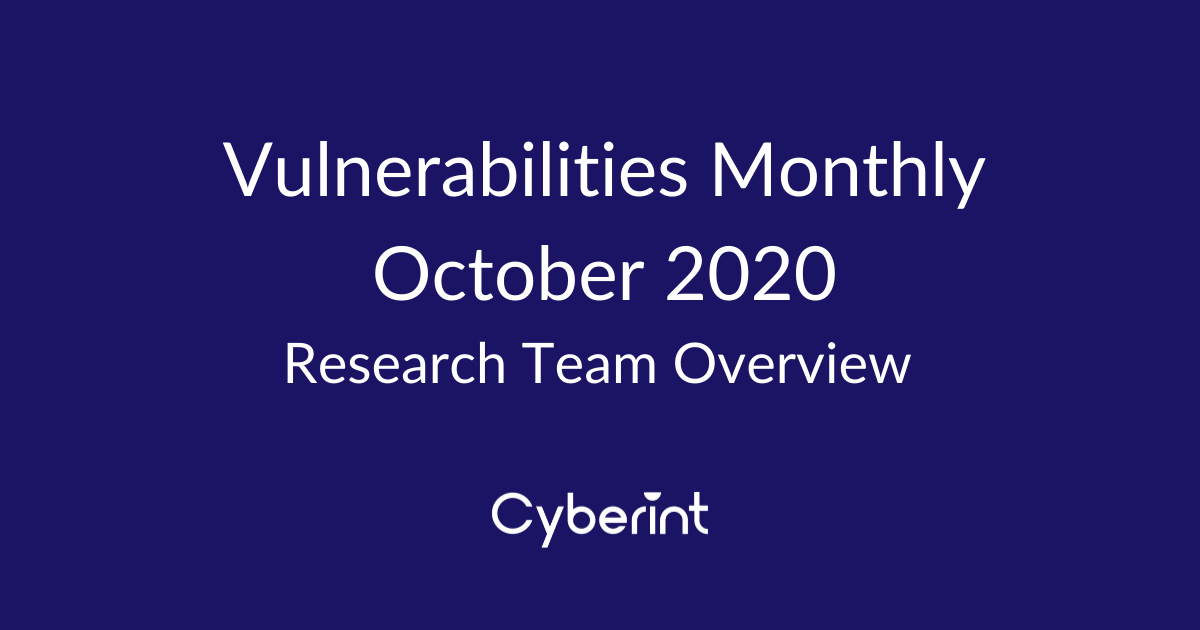


These vulnerabilities were observed to be critical in October 2020.
Cyberint’s Research Team recommends to patch and take the necessary steps immediately.
On Tuesday, October 13, as part of the October 2020 Patch Tuesday release, Microsoft has published a security advisory for CVE-2020-16952, a server-side include (SSI) vulnerability in Microsoft SharePoint.
The bug is exploitable by an authenticated user with page creation privileges, which is a standard permission in SharePoint, and allows the leaking of an arbitrary file, notably the application’s web.config file, which can be used to trigger remote code execution (RCE) via .NET deserialization
Several RCE vulnerabilities were found and reported to Microsoft, impacting Sharepoint.
All these vulnerabilities were binded under a single CVE.
Full Remote Command Execution over the Sharepoint server and highly potential lateral movement within the organization.
Impacted versions, include, but not limited to:
Exploits available? Yes – Metasploit and Python.
Exploitation observed in the wild? No.
CVSS Score: 8.6
Defenders can detect this exploit variant by identifying HTTP headers containing the string:
<!– 360Vulcan might not always appear –>360Vulcan: <**form runat=”server”** /><!–#include virtual=”/web.config”–>
As well as auditing SharePoint page creations.
The October 2020 SharePoint Security update addresses the vulnerability by correcting how SharePoint checks the source markup of application packages:
Please see:
The patch for CVE-2020-16952 enables blockServerSideIncludes in the VerifyControlOnSafeList()call within CreateChildControls():
– EditingPageParser.VerifyControlOnSafeList(this._dataSourcesString.Trim(), null, base.Web, false);+ EditingPageParser.VerifyControlOnSafeList(this._dataSourcesString.Trim(), null, base.Web, true);internal static void VerifyControlOnSafeList(string dscXml, RegisterDirectiveManager registerDirectiveManager, SPWeb web, bool blockServerSideIncludes = false)
CVE-2020-16898, also dubbed ‘Bad Neighbor’, is a critical remote code execution (RCE) vulnerability that arises when the Windows TCP/IP stack improperly handles ICMPv6 Router Advertisement packets using the Recursive DNS Server Option (“Option Type 25”) and an even length field value.
Due to the nature of this vulnerability, exploits are not easy to craft, and currently result in a Blue Screen of Death (BSOD), but they become available in the coming days the threat could elevate especially considering that this could be “Wormable”, that being a threat that could propagate from victim to victim.
CVSS Score: 9.0
An unauthenticated attacker who successfully exploits this vulnerability could gain the ability to execute code on the target server or client with high privileges. To exploit this vulnerability, an attacker would have to send specially crafted ICMPv6 Router Advertisement packets to a remote windows computer.
Impacted versions include, but are not limited to:
With affected builds including 1903, 1909 and 2004.
This vulnerability can be detected with a simple heuristic that parses all incoming ICMPv6 traffic, looking for packets with an ICMPv6 Type field of ‘134’ – indicating Router Advertisement – and an ICMPv6 Option field of ’25’ – indicating Recursive DNS Server (RDNSS). If this RDNSS option has a length field value that is even, the heuristic could drop or flag the associated packet as a potential “Bad Neighbor” exploit attempt.
[1] https://portal.msrc.microsoft.com/en-US/security-guidance/advisory/CVE-2020-16898
On October 20, 2020, Ben Hawkes of Google’s Project Zero warned Chrome users that Google had observed active exploitation of a zero-day in Chrome’s implementation of FreeType, a popular open-source font rendering library. As of October 20, the Chrome team has a new release out that includes a fix for the zero-day vulnerability, which is listed as a heap buffer overflow.
The CVE-2020-15999 flaw is a memory corruption bug that resides in the FreeType font rendering library, which is included in standard Chrome releases.
The researchers did not disclose technical details about the attacks exploiting the CVE-2020-15999 in the wild to avoid mass exploitation from threat actors.
Exploits available? Potentially yes, although not found, Google has mentioned that is aware of reports that an exploit for CVE-2020-15999 exists in the wild.
CVSS Score: 4
Detection steps were not released by Google or observed.
Upgrade Google Chrome to the latest stable version (86.0.4240.111) as quickly as possible.
[1] https://chromereleases.googleblog.com/2020/10/stable-channel-update-for-desktop_20.html
[2] https://twitter.com/benhawkes/status/1318640422571266048
A vulnerability in Pulse Secure admin web interface could allow an authenticated attacker to upload custom template to perform an arbitrary code execution.
Although considered Critical, exploitation is considered as Low due to the need to authenticate.
CVSS Score: 7.2
Impacted Pulse Secure versions, include, but not limited to:
Defenders should look for new page creations in the Admin Web Console.
Fill in your business email to start


